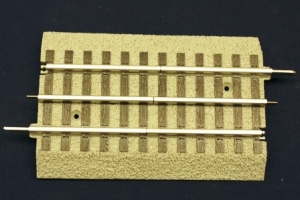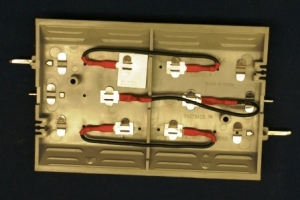Replies sorted oldest to newest
The only difference between the 2 is the metal plate underneath that joins the 2 outside rails. Usually used to extend an Isolated section that activates accessories when the trains wheels roll over , like the Lionel Crossing Grade with flashers. Insulated track is used between the accessory and an Isolated track section. One side of the outer rails triggers the accessory, so you don't want the metal plate joining the outside rails or it would not work. You don't want to use that for your regular track or you would have to attach 2 common wires to your track to keep both sides of the outer rails connected to common. The metal plate also helps if you get a loose track connection on one of the outer rails. Because they are joined together, that section would still get its signal from the other side. Isolated Block sections are different and only come in 5" sections. That have all 3 rails split in the middle and underneath have jumper wires you can remove to electrically isolate that rail, like when you want to turn off a whole section of track.
Track on right is the insulated Track, notice the metal plate is not there between the outer rails.
Below is an isolated section, top and bottom.
Attachments
Correct. Isolated Block sections let you kill power to say a siding or a leg in the rail yard. You just remove the jumper from the middle rail and then wire the one on the inner side of your section or leg to a switch or in my case the LCS BPC2 and can turn the siding or leg on and off as needed.
Fastrack switches that are o-60 and larger already have "integrated" isolated sections on both the straight and diverging routes.
If your switches are smaller you can add an isolated section between the switch and the siding. simply remove the center wire to break the power connection.


These are the larger isolated sections, I believe many if not all of the smaller "fastrack fitter" pieces have the wires and rail breaks to isolate a track.
Run the power wire from your transformer to the input of a toggle, run another wire out of the toggel the the center rail of your siding, and viola!
There is no need to break the outer rails.
The photo above is the isolated section. removing the center wire will remove power to your siding.
That piece will be the first section of track after the switch. Then add the rest of your siding track.
From there you need a power hooked up to the center rail on your siding track, after the isolated section.
There are tabs under fastrack to connect wire under every piece.
Run the power wire from your transformer to the input of a toggle, run another wire out of the toggel the the center rail of your siding.
Just wondering if Lionel makes fiber or plastic insulating track pins for Fastrak like they did for O Gauge and 027. With them we could make our own insulated sections to connect some of the old post war signals to Fastrak.
Thanks,
Chris
No insulating pins for Fastrack, but it is easy to make your own track sections . You have to remove the outside rail connecting bars under the track, and then just cut the rail at the length you want isolated. Lionel also makes isolated rail sections, but it only makes 20" sections.
Thanks for the useful information, I guess I better get the Dremel tool out. Another question, do you know the size and specs of the female spade connector that Lionel uses for Fastrak? The smallest size in my local hardware store was too large.
Chris
Chris,
Here is the YouTube video on making the activation track -https://youtu.be/NWKCyTdKgL4
The .110 quick disconnect terminals can be found at an auto store for a few or on eBay for 50 and 100 counts
The 6-12036 FasTrack Grade Crossing Track has no metal plate underneath it. Can this be compatible with the insulated track?
I don't have one in front of me, but if there is no connections between the outer rails, it can be used as an insulated section.
Brendan
You can make your own insulated fastrack section by removing underneath the joining metal tabs to the outside rails. Then taking out one side of track pins and maybe filing down the one side rail slightly so it does not touch the other 2 track sections.
For clarification - Lionel calls the section of track with no outer rail connections underneath "insulated" and the track with the gap "isolated".
Brendan
@Brendan posted:For clarification - Lionel calls the section of track with no outer rail connections underneath "insulated" and the track with the gap "isolated".
Brendan
So does this mean the grade crossing track is insulated?
Anyway, here are two images of the top and bottom of the grade crossing track. Notice that the metal plate is nowhere to be seen.
Attachments
@Brendan posted:Yes
Brendan
Well, it means the 3 rails and especially, the two outside rails, are electrically separated. This permits the piece to part of a longer "trigger" configuration for crossing signals without having to modify it. The trigger rail would begin and end before and after this piece of track. The signals would presumably be near the roadway.






